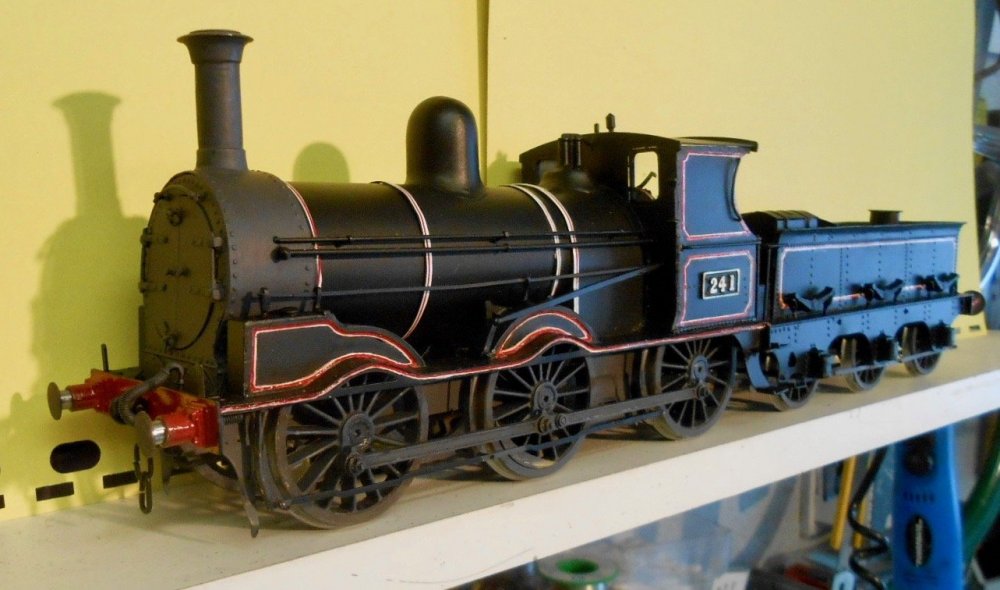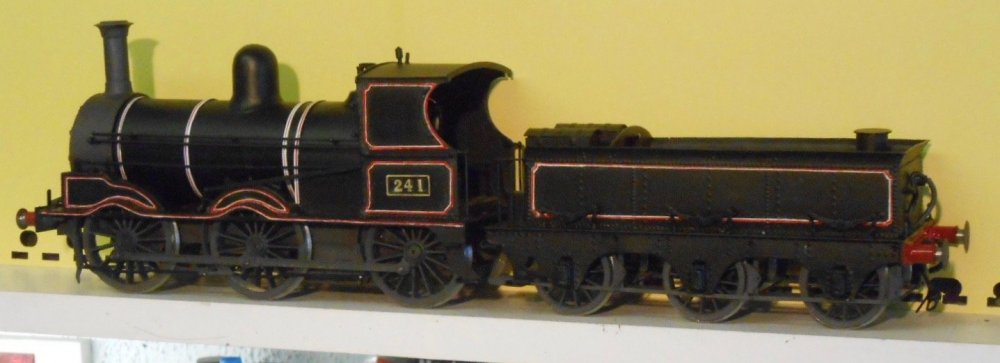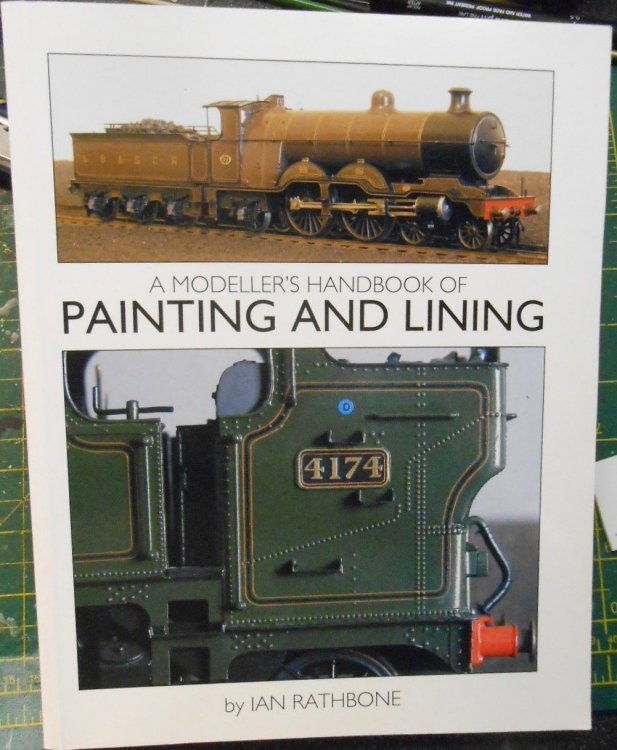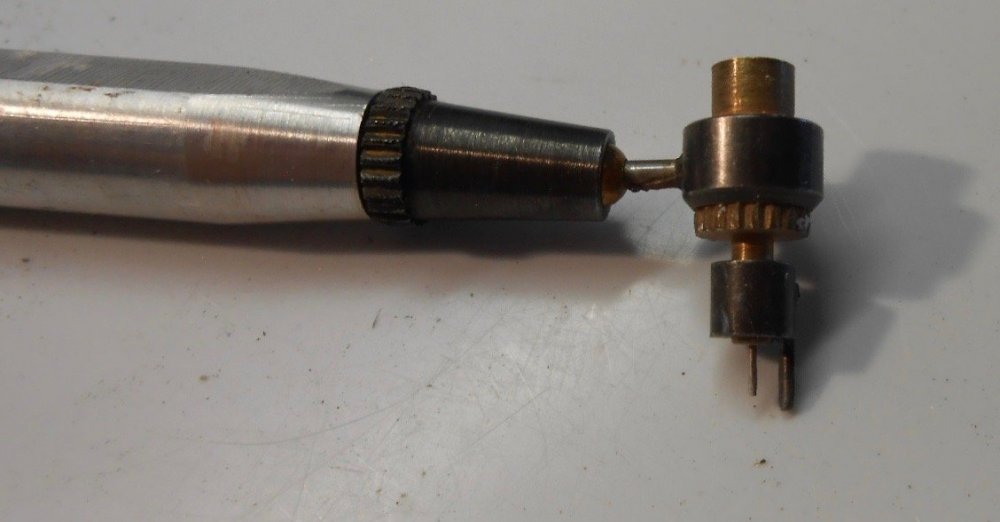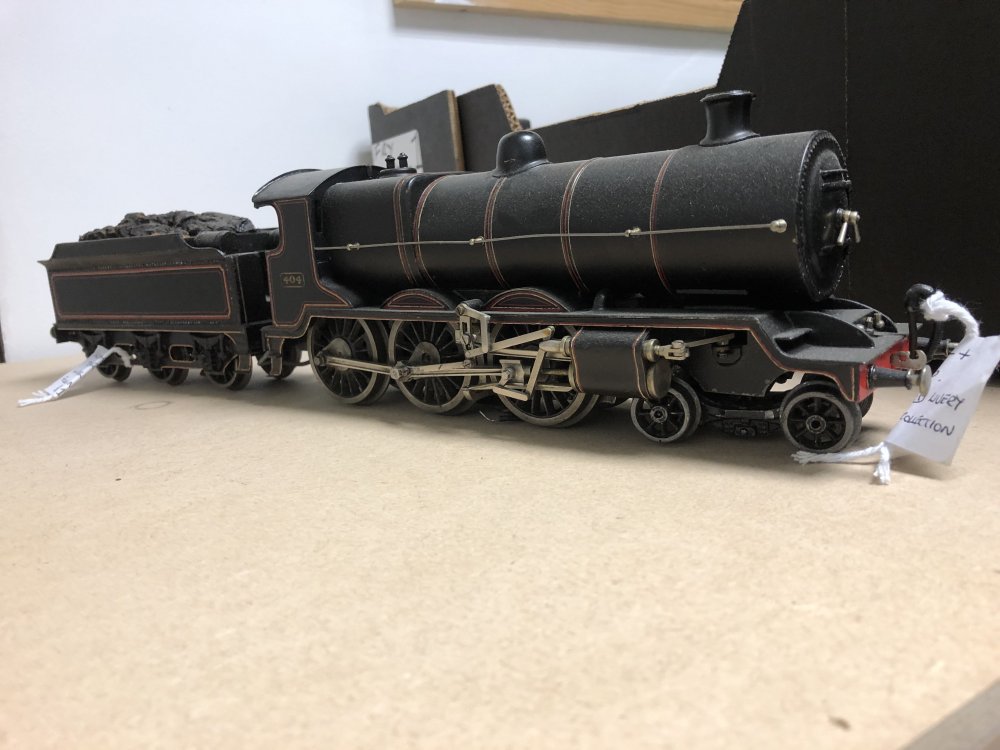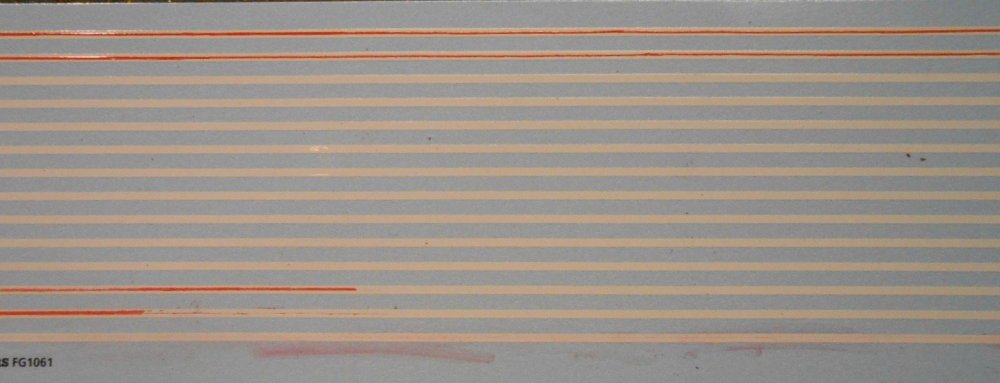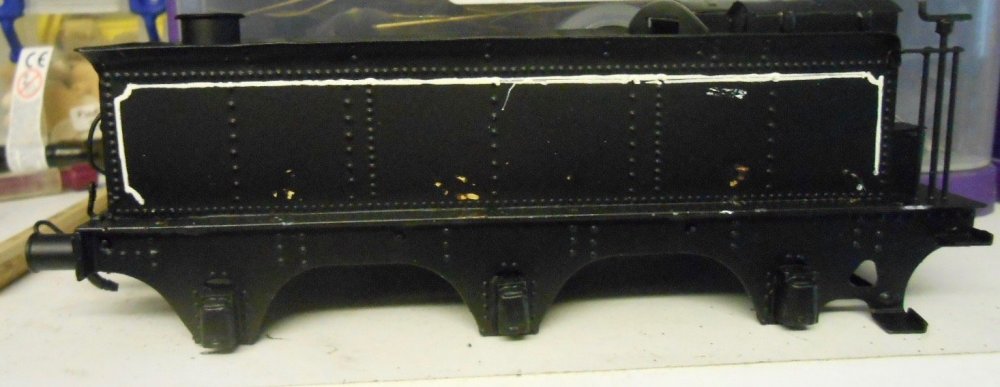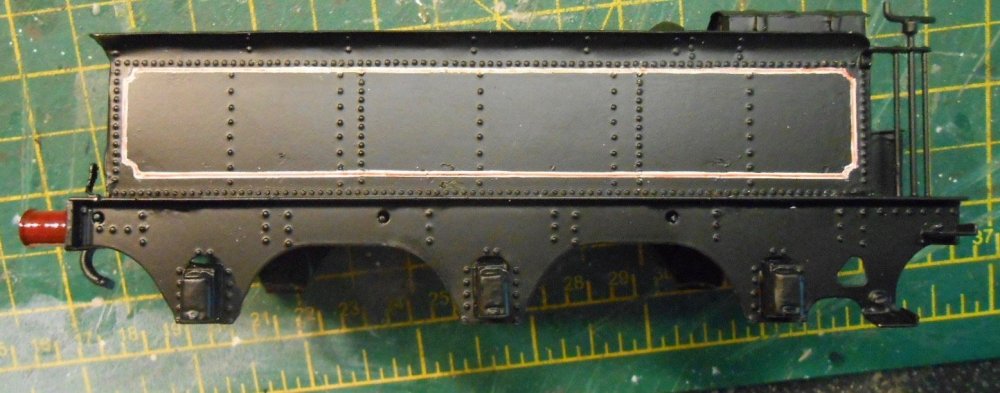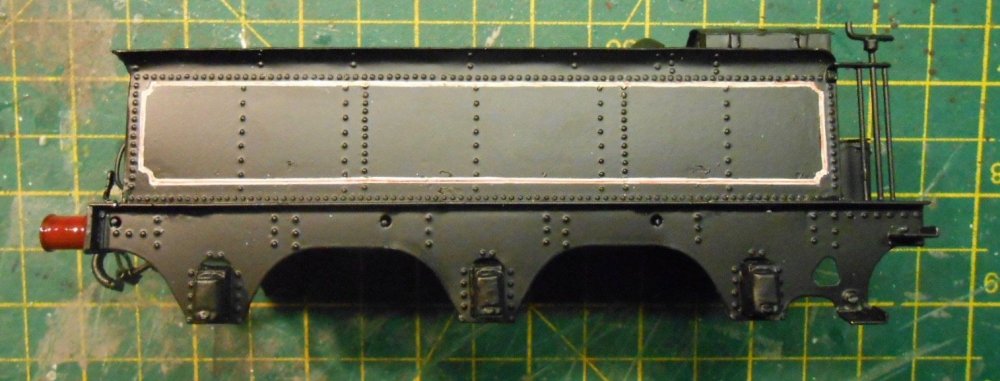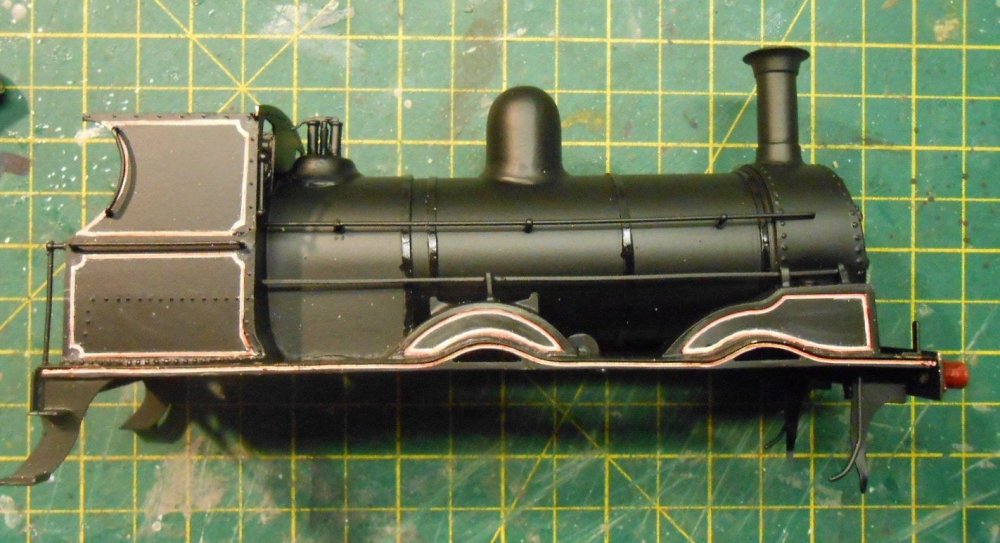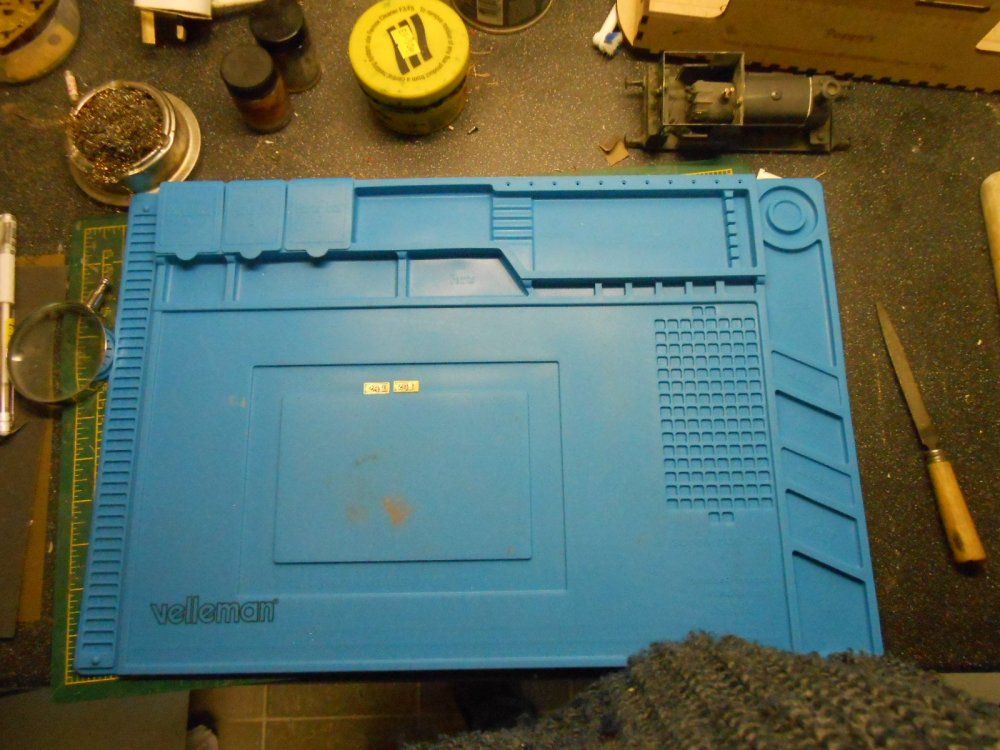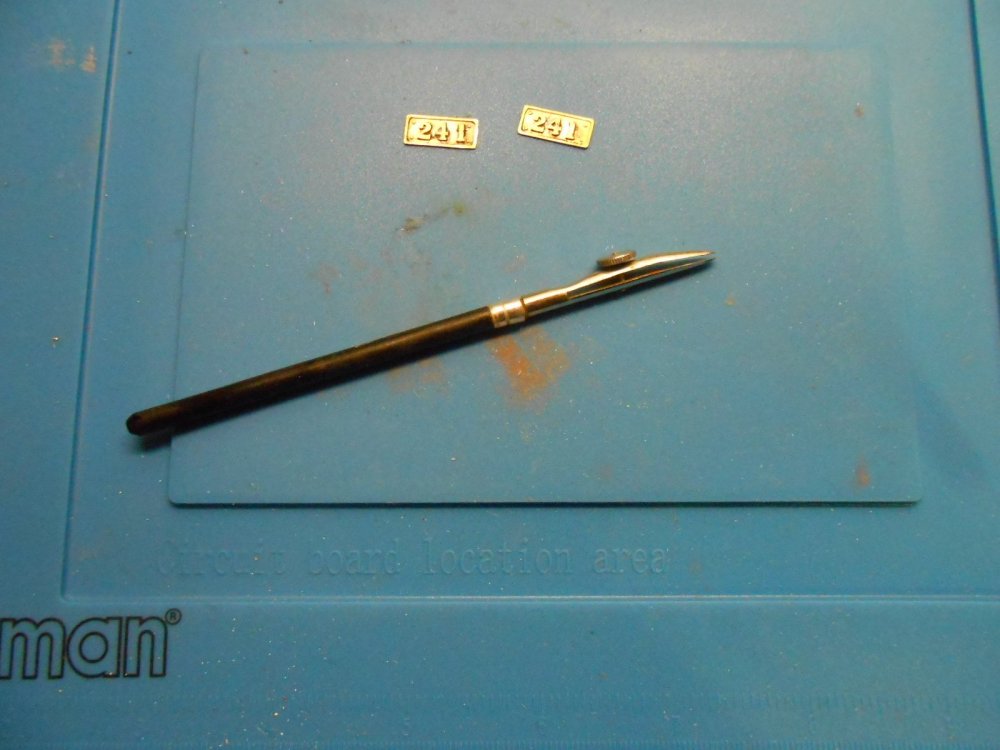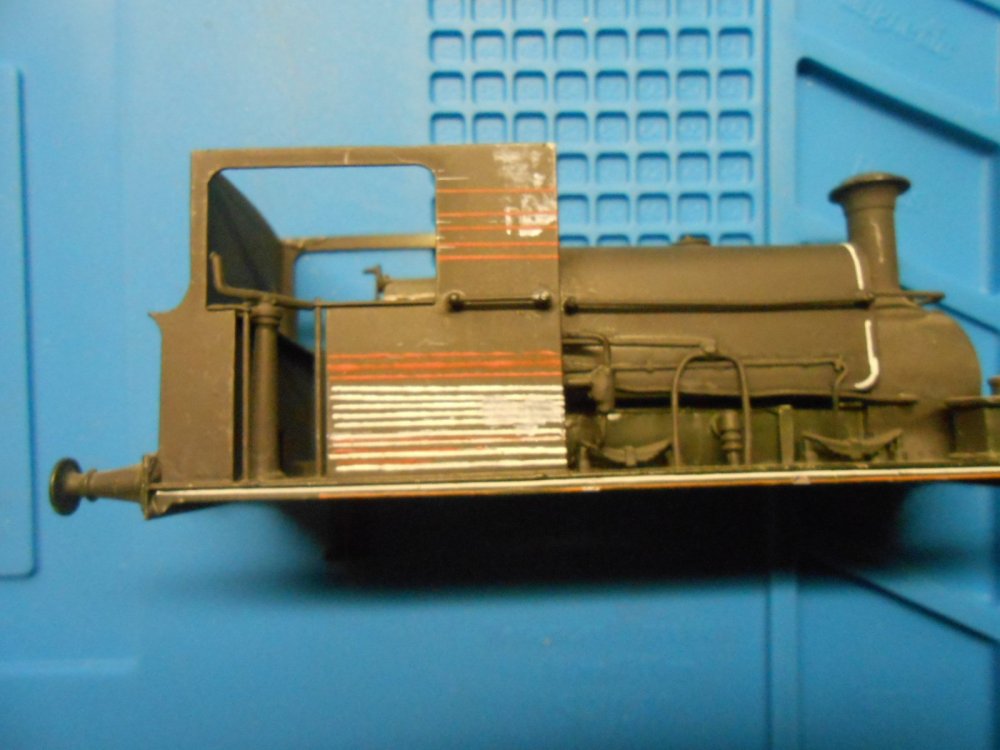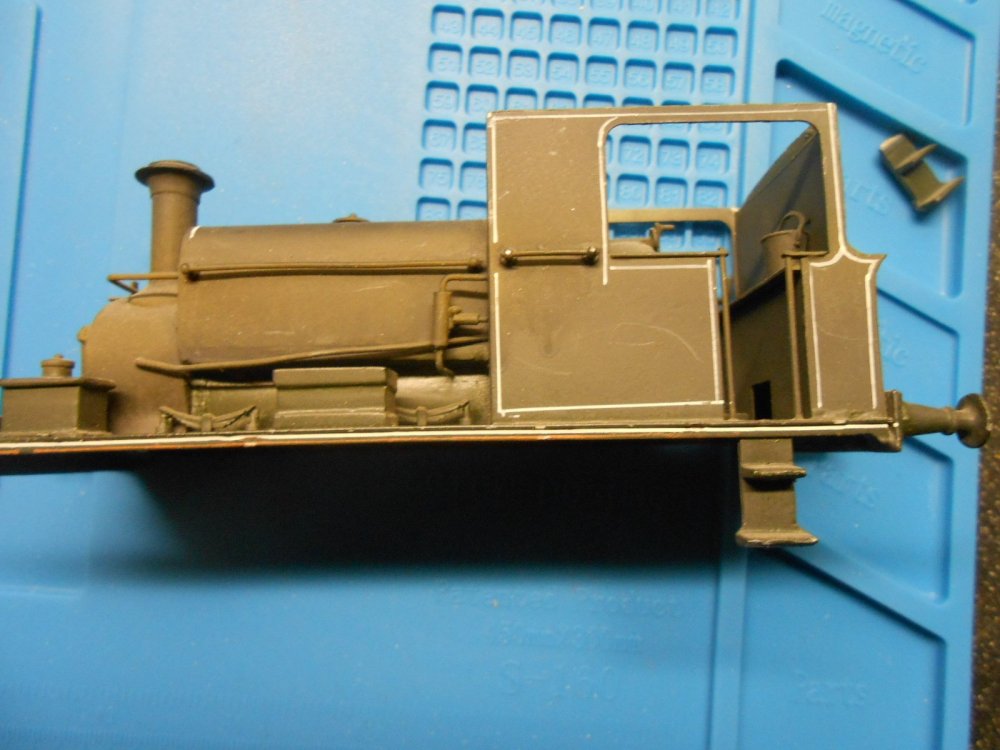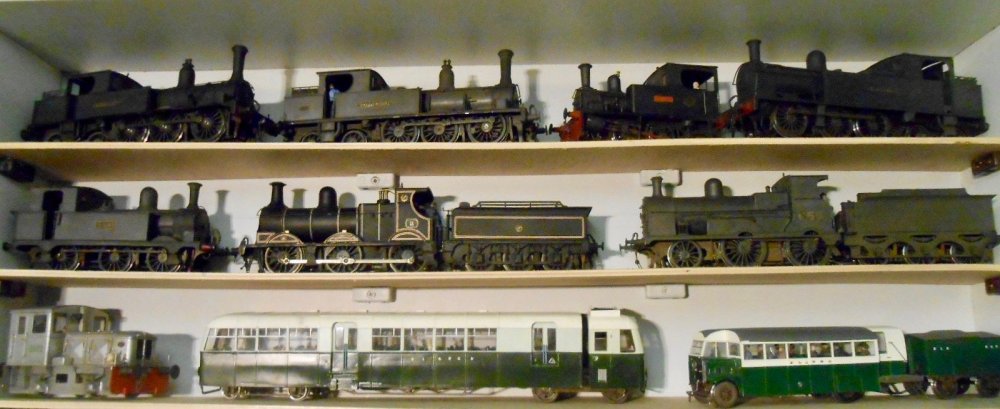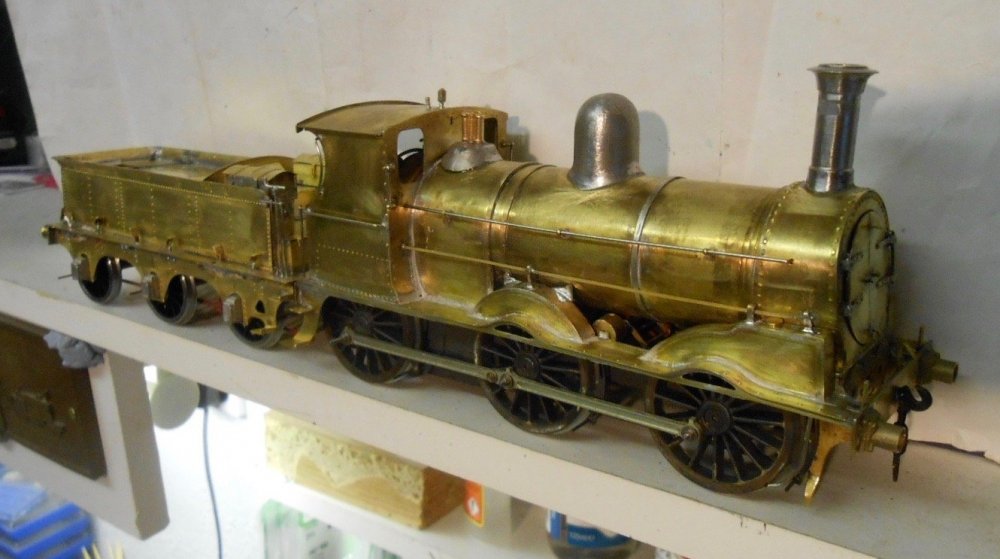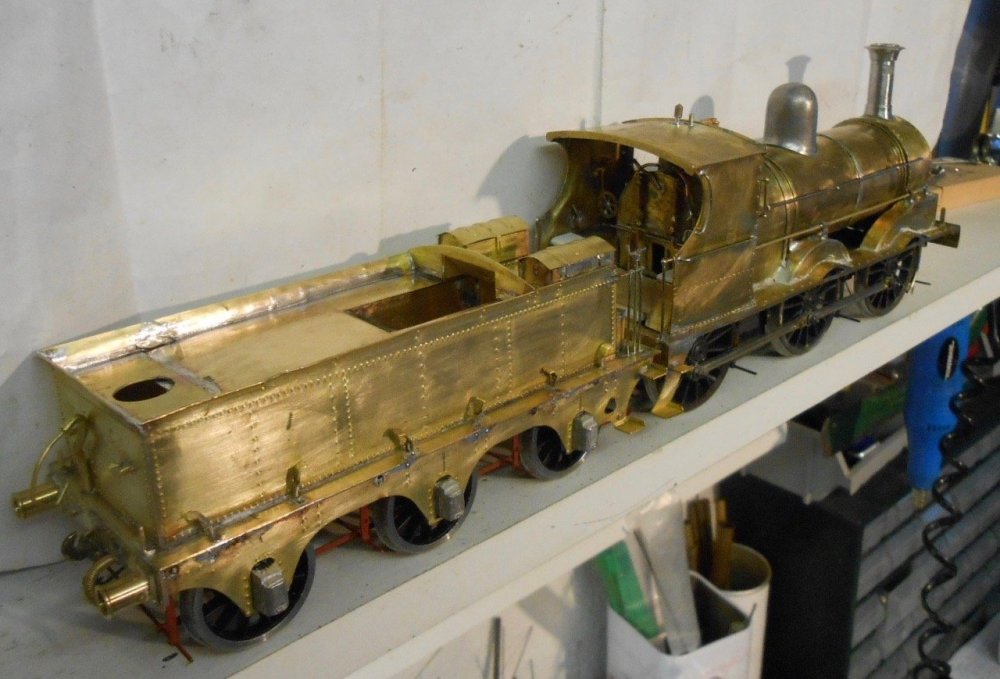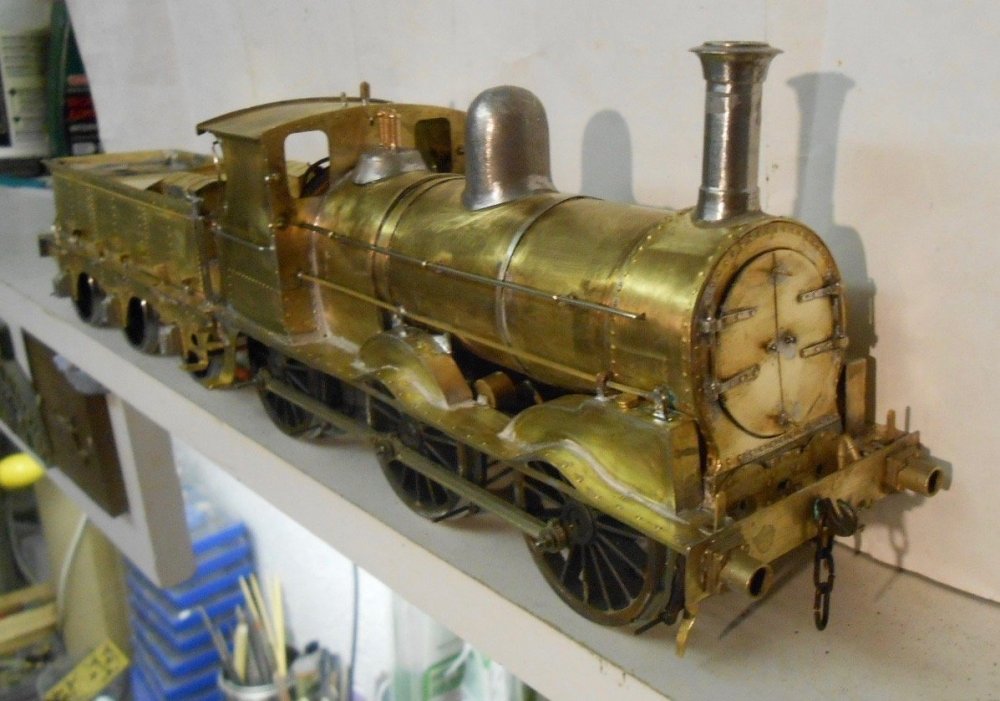
David Holman
Members-
Posts
4,359 -
Joined
-
Last visited
-
Days Won
117
Content Type
Profiles
Forums
Events
Gallery
Everything posted by David Holman
-
7mm scale 101 - a tribute to Richard Chown
David Holman replied to David Holman's topic in Workbench
Getting there, at last Much of the last week has been spent on fettling the lining. In the end, I went back to enamels and persevered until I got a suitable 'double cream' thickness, as recommended in Ian Rathbone's book. My cheap [£12] bowpen can do reasonably fine lines with practice, but the key to success is the tidying up technique in the book. Essentially, one waits a couple of hours, then use a fine brush, dipped in thinners to ease away any imperfections in the drawn lines. Tedious, but effective & surprisingly therapeutic once you get into it. The trouble is that, every time you stop for a few minutes, when you look again, you see ever more imperfections. However, the lining is now looking better than it was and is probably at the limit of my current pen. I put in the white line first, then after letting it harden for 24 hours, did the red line inside it. There should be a further red line a millimetre or so inside the first one, but have chickened out of that for now. Corners were done freehand with a fine brush and tidied up as before. Other work has included: Painting the buffer beams red - though I now fear the tender one should be black Adding the vacuum and steam heating hoses [Slaters] Brush painting the smokebox/chimney a very dark grey Tidying up the cab. Things like scraping paint off the copper pipework and brass gauges, then adding the cab roof Fixing the outside brake rodding Fitting the tender springs above the footplate Making & fitting the two number plates Adding balance weights to the wheels lining the boiler bands The last mentioned was a bit of a faff - as first I had to draw a thin red line down the centre of some white lining transfer strips, then [with much cussing and swearing], persuade the strip to go round the boiler & inside all the pipework, splashers etc. There are still a few things to do, not least fix the crew and put some coal in the tender. Made a fall plate this afternoon, which still needs painting & fitting, while the loco number needs to go on the buffer beam. My best guess is that this should be in shaded gold or yellow. Having never thrown away a transfer sheet, you'd think I'd have something suitable. But no. Some Midland Railway coach lettering is about right, but there are only 1s and 3s, which is a bit of a bummer. Given the cost of a lettering sheet will exceed £10, I may well do the letters by hand. So, there we are - getting there, but even as I tick one more thing off the list, I notice something else: like this afternoon that there is no link between the tender brake standard and the operating rods below the footplate. In practice, a short piece of 1mm wire, but it will still need blackening & painting, so there's another half required. Life is complicated, which is why it's fun, as they say. -
Looks the business, Ken, especially that Sligo wagon!
-
That is one very fine viewpoint. Good to see this layout again.
-
7mm scale 101 - a tribute to Richard Chown
David Holman replied to David Holman's topic in Workbench
Paintshop I'm starting to think that painting the 101 could take as long as building it. First comes the 'witness coat', in this case red primer, which [mostly] shows where all the holes and excess solder are that you thought you'd cleaned up beforehand. Once these have been filled and scraped/filed/sanded down, on goes another spray of primer, and then, like as not, you find some more and have to go through the process again. It's a real test of patience... When that is done, there is a wait of 24 hours before the top coat can be sprayed on - in this case matt black, then another overnight wait for that to harden too. Having built over 60 locos, all the above is second nature, but not the next bit! All my locos have been in 1950/60s livery in the past - black, with varying degrees of weathering, which can cover a multitude of sins. The 101 is going to be in almost 'as new' condition, which means lining, for which, as far as I can tell, no transfers exist, so from now on it is a very steep learning curve. Thanks first to Eoin, for reminding me of my copy of Ian Rathbone's book on painting and lining. Have used it a lot, but had never read the lining chapters, until now, but they are very helpful, even if the results Mr Rathbone achieves are more than a bit intimidating. Just look at those cover photos - hand lined, with a bow pen and fine brush! So treated myself to a bow pen, bought some new fine marker pens, enamel and acrylic paints to go with my R L Moore lining pen and set about doing a bit of practicing. I also bought some plain white lining from Fox Transfers, to form the basis of the boiler bands. Having earlier sprayed a piece of plasticard black, I tried various ways of lining. Jonathan Beaumont kindly provided me help in the form of photos of one of Fry's locos, however I have to admit I've chickened out of trying to replicate it, because [for now at least], it is well beyond my skills and tools. Check out the boiler bands - white/black/red/black/red/black/white! Ok, so the white lines are outside the boiler band itself, but there is now way I can get a black line thin enough to go in the middle of the red one. So, what I'm attempting is a simplified white line, with a thinner red one down the middle. Hence the white transfers. Using red acrylic, I've managed to draw a red line down the centre, which hopefully will look ok once I've made the lining thinner. The next picture shows my first attempt at doing a white line on the tender. Not good! However, using white acrylic means that it can be tidied up by using a combination of scraping paint away with a cocktail stick and touching up with a fine, 3/0, brush. The corners were brushed in by hand and tidied as before, then once the paint had hardened, I then drew a thin red line down the middle of the white one. The loco body has had the same treatment, but all those curves are proving really challenging. The splashers and valances aren't too bad, because there is beading to follow, for the white line at least, but it is far from perfect. I've stuck with the bow pen, as the Moore one is designed for neat Humbrol. For me, a big issue is that the red is not drying dark enough. The actual colours, according to 'Steaming Through Three Centuries' should be vermillion, bordered with white. However, white looks far too bright against the dark black, so am using ivory instead. Vermillion is bright red, but on top of the ivory has a rather pinkish tone, so am looking to darken it somewhat. I think the real problem is I haven't been able to do the lines at scale width [they are very fine on the prototype], so probably need to invest in a better quality bow pen to achieve that. On the other hand, the lining is as fine, if not a little bit finer, compared to what Richard Chown achieved on Shannon, so at the moment, this is what I'm aiming for. It remains very much 'work in progress' though and until I've got all the lining on, plus numbers etc, I'm not sure whether it will overall look good enough. PS, as I feared, the phots have uploaded is the wrong order, but hopefully you can work out the correct one. -
You've made your own R L Moore lining pen, Eoin! Will post a picture of mine, later. Have been experimenting with acrylics in the bow pen, to reasonable effect. Ian Rathbone's book contains a wealth of dodges, not least how to correct mistakes. With acrylics, a cocktail stick and a fine brush can work wonders!
-
Thanks Eoin. Had forgotten about that. I have a copy and very good it is too.
-
Bought a couple of new toys at the Tonbridge show this weekend. The first is a silicon soldering mat that I got from the Squires stand. Works up to 500c and contains all manner of small compartments to stop stuff disappearing, plus a couple of magnetic areas as well. Already wondering how I ever got on without it, having soldered etched brass numbers to my 101's plates without any singing or nasty smells that emanate from the bit of 12mm ply I usually use. Also treated myself to a basic 'bow pen'. Having heard all sorts of stories about them [few good] over the years, I found time to have a chat with Chris Heacham, proprietor of Golden Arrow Models and very helpful he was too. First experiences decidedly poor, as you can see from my much abused industrial loco body. One of these days, I ought to make a new chassis for it, as it is a fair lookalike for several Irish industrials. Will need to soak off about 1mm of paint first though, as it has been a test bed for spray painting for a while now. Anyway, though neat Humbrol is the usual go to for lining with a bow pen, recently I've found myself less happy with what is in their tinlets. Used a brand new red and ivory to try the pen, but the paint is just took thick and despite various attempts to thin it, including lighter fuel, things have not gone well, as you can see. Enamel paint takes ages to dry, and would then need sanding back and respraying to deal with any mistakes - something I don't want to be doing once I start on the 101. Hence have been trying acrylic and my Model Colour 'Vallejo' squeezy bottles seem much better, with the advantage of mistakes able to be wiped off with a damp cloth too. The nozzle means you can put paint directly into the jaws of the pen, rather than having to dip & then wipe. The improvement in the second photo is considerable, methinks! Would welcome any comments/advice on the use of bow pens - I really am a complete beginner.
-
And Mary, Joseph, the donkey and all the angels.
-
Storage of rolling stock when not in use
David Holman replied to CFD's question in Questions & Answers
Cassettes might be an answer. Arrange a single spur that leads to a space long and wide enough. Your cassettes could be just plain track on a narrow length of 12mm ply. How long depends on how confident you are, but you could have as many as you like and store them on a sliding shelf under the layout. -
Fascinating. Thanks Warb. The latest edition of the Gauge 0 Gazette contains an article on laser cutting, which backs up what has been said already. However, a few things not mentioned include: The author uses a 35 watt CO2 laser, which is water cooled so in addition needs a tank of water and a pump to circulate it. You can buy one for about £2000, plus VAT, but derivatives can be found on Ebay for about £400, apparently The laser tube lasts about 1000 hours and costs £250 to replace Materials that work well with a laser cutter include cardboard, Perspex [acrylic sheet], but NOT styrene/plasticard. Mylar [polyester sheet] cuts well, but can be difficult to glue. MDF and plywood both work well, which is why there are a fair few commercial laser cut kits available now. However, as Warb says and very much along the same lines as 3D printing, first you need to know CAD, which takes time and effort to perfect. Clearly worth it, when you need the amount he is using! The alternatives include contacting the likes of York Model Rail, who produce a wide range of laser cut windows, doors etc and who will do custom jobs too. Schools and colleges may have laser cutting equipment that you might be able to access, while the author of the Guild article, Bob Gledhill has written a book on the subject. Laser Cutting and 3D Printing for Railway Modeller; published by Conwood Press ISBN 978 78500 226 7
-
With Arigna Town now retired from the exhibition circuit, it seemed appropriate to put some of the stock on display at home, rather than have it hidden away in boxes. Makes a nice reminder of what I've made over the last few years. Left to right, we have two SLNCR Small Tanks [both North Star, now Studio Scale kits], Timoleague & Courtmacsherry 0-4-2T Lark [Tyrconnel kit], SLNCR Large Tank, Sir Henry [scratchbuilt]. The second shelf has E/J26 0-6-0T [Tyrconnel], Richard Chown's Shannon, and MGW G2 2-4-0 [Tyrconnel] The third shelf has Deutz G class diesel [Worsley etches] and SLNCR Railcar B, with Railbus 2a [both scratchbuilt].
-
Laser cut? Be interesting to read more about how you do this, given that (whatever the method), windows are very time consuming and hard to get consistent. These look the business!
-
Thanks both of you, though even enlarged, things are still not clear. Hopefully JHB can enlighten me when he gets back!
-
Better still, use it to replicate whatever loco it came from? Fair bit of scratch building needed, methinks. Any takers????
-
CIE Laminate Coaches - Worsley Works - ECMbuild in 4mm
David Holman replied to murrayec's topic in Irish Models
Lovely stuff. There is so much we can learn here. Note to self: next time I build a coach, check out Eoin's clever jigs and other building aids! -
7mm scale 101 - a tribute to Richard Chown
David Holman replied to David Holman's topic in Workbench
So, where was I? Is it really four weeks since my last post on the 101? An exhibition, man flu [far worse than bubonic plague of course], household chores and the like - they all eat into modelling time! However, as might be gathered from other posts, work has progressed on the 101's tender and the model has now reached the stage where it is not far off the paint shop. The tender, like the loco, proved interesting, to say the least. Frames were straightforward, with 5mm brass rod used for spacers, drilled to take 8BA bolts to fix to the body. At first, this was easy too, the only awkward bit being forming the flares along the top edge. The etches contain a fair amount of detail, including the distinctive tool boxes, plus all the brake gear too. Here is where it started getting complicated, with pull rods both inside and outside the wheels. The real difficulties arose in trying to work out what the original, 1864 gallon, tenders were like on top and at the front. The instructions and photos are of the preserved version, while pictures in books rarely show more than three quarter views of the whole loco, so you are left having to guess what is going on elsewhere. The etches do not cover the tender top surfaces, while [to me at least], it was hard to make sense of the coal space. In the end, I fabricated both from thin brass sheet and it seems ok, while all photos show the tender top liberally covered with coal, so what is underneath hardly matters. Having bemoaned the number of handrails on the loco [eight around the cab alone], I then found there are a further four on the tender. The GSW certainly didn't want its crews falling off the footplate, it seems. As with the loco though, there are no castings in the kit, so I had to source things like springs, axle boxes, buffers etc. I managed to find some suitable spring/axlebox castings at the Reading trade show in December. A fair bit of fettling has been required - separating spring from 'box and filing the latter so they fit in the outside frames. The springs themselves then needed hangers so they can sit on the top edge of the footplate. The etches contain plenty of hangers, but they are flat, so I soldered short lengths of 1mm brass wire to each 'leg' and then rounded this all with a file. This has meant I could drill holes in the footplate surface to take each of the 12 legs. The springs themselves will be glued in place with 5 minute epoxy, probably after painting, because otherwise lining the tender will be difficult. Several things can't be finished until I've visited the Roxy stand at the Tonbridge show next Saturday. A couple of short handrail knobs for the smokebox, a set of etched numbers for the number plates and some sub-miniature plugs and sockets so I can add pick ups to the tender. Hopefully, everything will be ready for priming by then, though this phase can be quite fraught at times. Witness coats do have a habit of showing up unwanted blemishes that then need filling and priming again, while cleaning up always seems to find a few weak solder/glue joints that need doing again. Getting there though. Life is complicated - that's why it is fun. Allegedly... -
Keep 'em coming, Warb. There is much to learn and enjoy here.
-
My 101 is nearing the paint shop stage and livery for the early 1900s is stated as " black, with vermilion lining, edged in white". So, my question is, does that mean a white line either side of the red one, or just one side? And if so, which side - top or bottom? It is very hard to tell from contemporary monochrome photos. Also, can I get away with a wider white line that has a red line down the middle, or were there spaces between the white and red? 7 mm scale remember, so such things are potentially more noticeable.
-
Fabulous. Now that really guilds the lily.
-
A few windows and doors needed too, methinks! Presumably, will be standard size and mass/custom made?
-
I did! Thanks Jonathan. Looked in the 101 loco section and forgot all about the tenders bit. Making progress and will post some pictures next week, but what I will say is that the 101s had a ridiculous number of handrails. 8 just around the cab with four more at the front of the tender.
-
Excellent! Proof, if needed, that printed card works just as well as embossed plastic for buildings. The layers of detail lift the flat surfaces and show what could be done with Metcalfe kits (many of attractive subjects) to cover the exposed corners. Always nice to see individual, scratch built models and this one is a beauty.
-
Many thanks, folks. Key info from Mayner that raves/extensions were not fitted in GSWR days, so a 'flat top' it will be - with a good layer of coal all over. Two cracking photos as well.
-
Well worth a detour if it is at a show in your area. Captures the atmosphere of the prototype beautifully, especially now the village street back scene is nearing completion. 21mm gauge too, which makes it all the better. Prototype modelling at its best! Courtmacsherry is also worthy of study as what must be close to the perfect branchlike setting - regardless of prototype/gauge/company. Sea wall in the foreground, quayside siding, village street as the back scene and the loco shed [or the school] are conveniently place to hide the hole in the sky to the fiddle yard. Why the track plan hasn't been copied much [indeed, at all?] is a real mystery.
.png.c363cdf5c3fb7955cd92a55eb6dbbae0.png)
